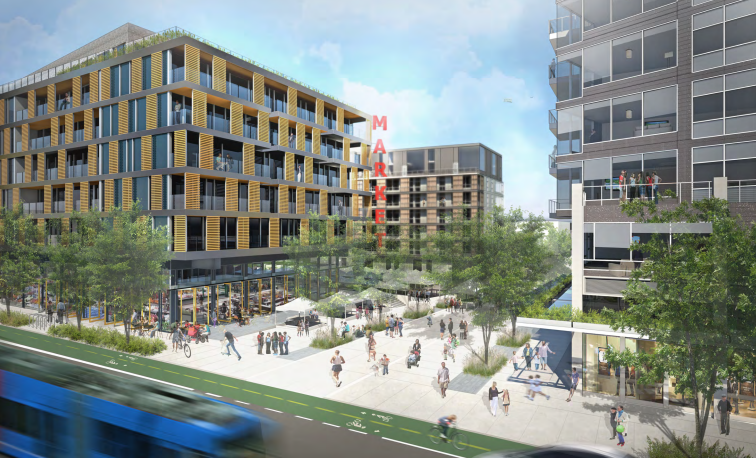Capitol Hill, a neighborhood awash with transit-oriented development, is poised to get a lot more right where it is needed. At a meeting last week, the Sound Transit Board of Directors authorized a long-term ground lease agreement for three sites at the Capitol Hill light rail station. The deal would give Gerding Edlen and its equity partner exclusive rights to develop the sites with an immense amount of housing, retail, and public space. The move comes just one month after the Board of Directors authorized a separate agreement with Gerding Edlen and Capitol Hill Housing to develop another site at the station for affordable housing.
Background and Project Details
The Capitol Hill Station sites consists of one large block and two smaller ones on Broadway, which Sound Transit plans to breakup into six development sites. Sound Transit has agreed to sell a small sliver of land on the southwest block on E Denny Way and Broadway (Site D) to Seattle Central College due to its proximity to the college campus. Word is that the property could eventually become student housing. The agency has also agreed to sell another site at southwest corner of E John St and 10th Ave E (Site B-North) to Gerding Elden and Capitol Hill Housing for affordable housing. The remaining three sites (Sites A-North, A-South, B-North, and C) will all be leased to Gerding Edlen and its equity partner Multi-Employer Property Trust for mixed-use development.
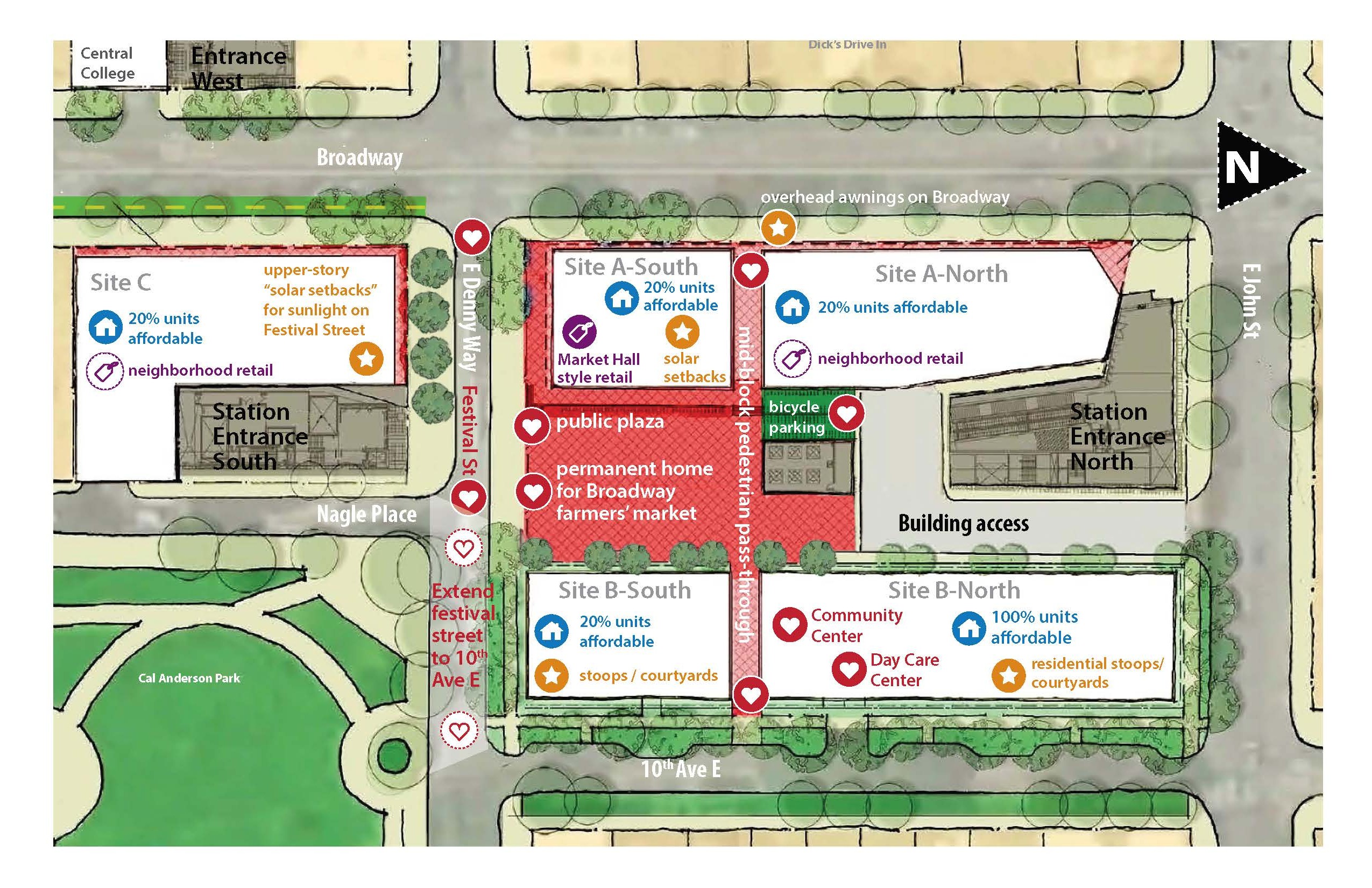
Under the terms of the long-term lease agreement, Gerding Edlen and its equity partner would be committing to a big investment at the Capitol Hill Station sites. For starters, the joint venture would be tasked with building a new public plaza and creating an outdoor space suitable for the Capitol Hill Broadway Farmers’ Market. Somewhere between 315 and 332 residential units would be built across the leased sites with about a third geared toward small families (2+ bedrooms per unit). At least 21% of the units would be rented at affordable rates for 12 years to households making between 85% and 65% of the area median income. Gerding Edlen would also put a lot of effort into developing a significant street level retail program that includes a “market hall” concept for micro-retailers. And that’s all just for the ground lease sites.
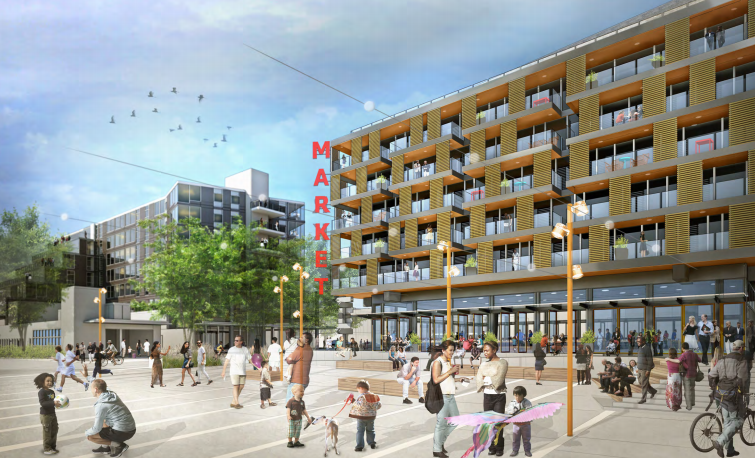
Gerding Edlen will also tasked with building up to 90 affordable residential units rented at or below 60% of the area median income on Site B-North and developing a community center and daycare.
Through Capitol Hill Champion, the community has pushed for open space and affordable housing and on both fronts, that vision has clearly won out. Gerding Edlen will easily build more than 400 residential units at the station and hold at least 37% of them as income-restricted, helping to put many of the people who need transit most the closest to it. Sound Transit has also conditioned the lease with public open space. The plaza will be built as a flexible space open at least 16 hours daily to the public and geared toward supporting a farmers’ market all year long.
While there aren’t too many flashy renderings of the future developments, Gerding Edlen has offered some insight into their development strategy.
Market Hall
In describing the Market Hall concept, Gerding Edlen says that:
The Market Hall at Broadway and John (Site A South) will be a mix of local retailers, served by booths of varying sizes to accommodate the start-up entrepreneur as well as more established specialty retailers. This bazaar-type setting will reflect the eclectic nature of the Hill but also provide high quality, locally produced goods that are expected by its residents.
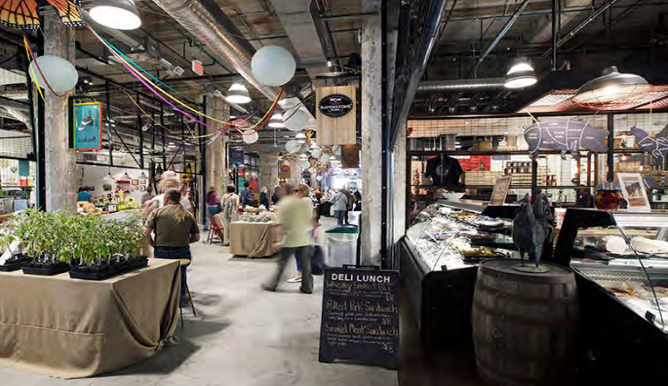
…[L]ocal retailers will be in 600 to 800 square foot retail stalls in an open, bustling environment…
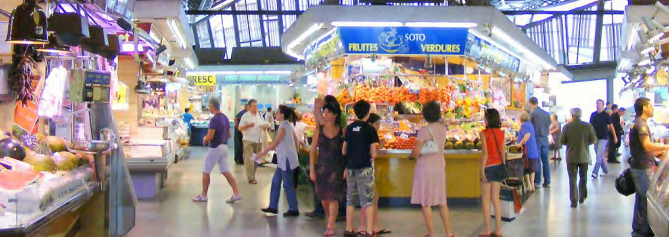
…[T]he Market Hall – is a large, single volume space defined by a structurally expressive ceiling plane. Within a prescribed module, retail booths are arrayed to form pedestrian aisles that have a direct link to the outside via the pivot doors….Grouping [the vendors] in the hall capitalizes on the vibrancy of the crowds wandering amongst the stalls, similar to traditional markets, such as Pike Place or the recent Melrose Market. Furnishings within the Market Hall will allow patrons to enjoy food or their new retail purchase. On busy days, patrons can seamlessly move through any of the four perimeter walls to Broadway, Denny, the Plaza, or the pass-through.
So not only will the station have a robust farmers’ market, it could end up having a very traditional indoor marketplace.
Going Green
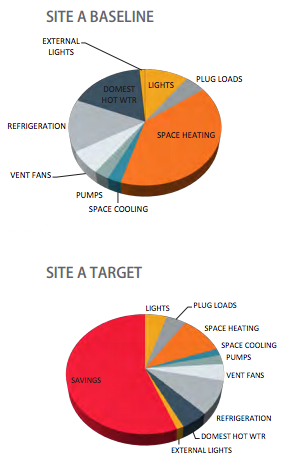
Gerding Edlen hopes to construct a very green project:
…[S]trive to meet the energy reduction requirements of the Architecture 2030 Challenge[, which] specifies that any building constructed between 2015 and 2020 must perform 70% better than the existing building stock in its region. After 2020, the requirement increase to 80%, after 2025 to 90%, and after 2030 to net-zero. On-site renewable energy is allowed to account for up to 20% of the required savings….In addition to carbon reduction, the lower energy use reduces building operational cost, reduces infrastructure requirements, future proofs the building against rapid utility price increases, and in some cases, adds resiliency to the design in the case of prolonged power failure.
The average mixed-use multifamily residential building with a ground floor grocery in Seattle uses about 83 kBTU/sf/year in energy. This metric is referred to as the building’s “Energy Use Intensity,” or “EUI,” and represents the total annual energy use of a building divided by its floor area. It is comparable to a building’s gasmileage rating, except that a smaller value is better. The 70% reduction required by Architecture 2030 sets an energy-use target for the new buildings of about 25 kBTU/ sf/year. Of this, up to about 17 kBTU/sf/yr is allowed as on-site renewable energy. This results in a maximum allowable energy use before renewables of 42 kBTU/sf/yr.
If the development achieves these standards, it will be well beyond the goals set by Sound Transit.
Pass-Throughs
On the main station site, Gerding Edlen hopes to employ pass-throughs to efficiently use space above and create a unique design pulling people into the courtyard beyond. In describing the pass-through for Site B-South, Gerding Edlen says that:
The B-South lobby opens directly onto the pedestrian pass-through, via a full-height glazed storefront extending 40% of the length of the pass-through.
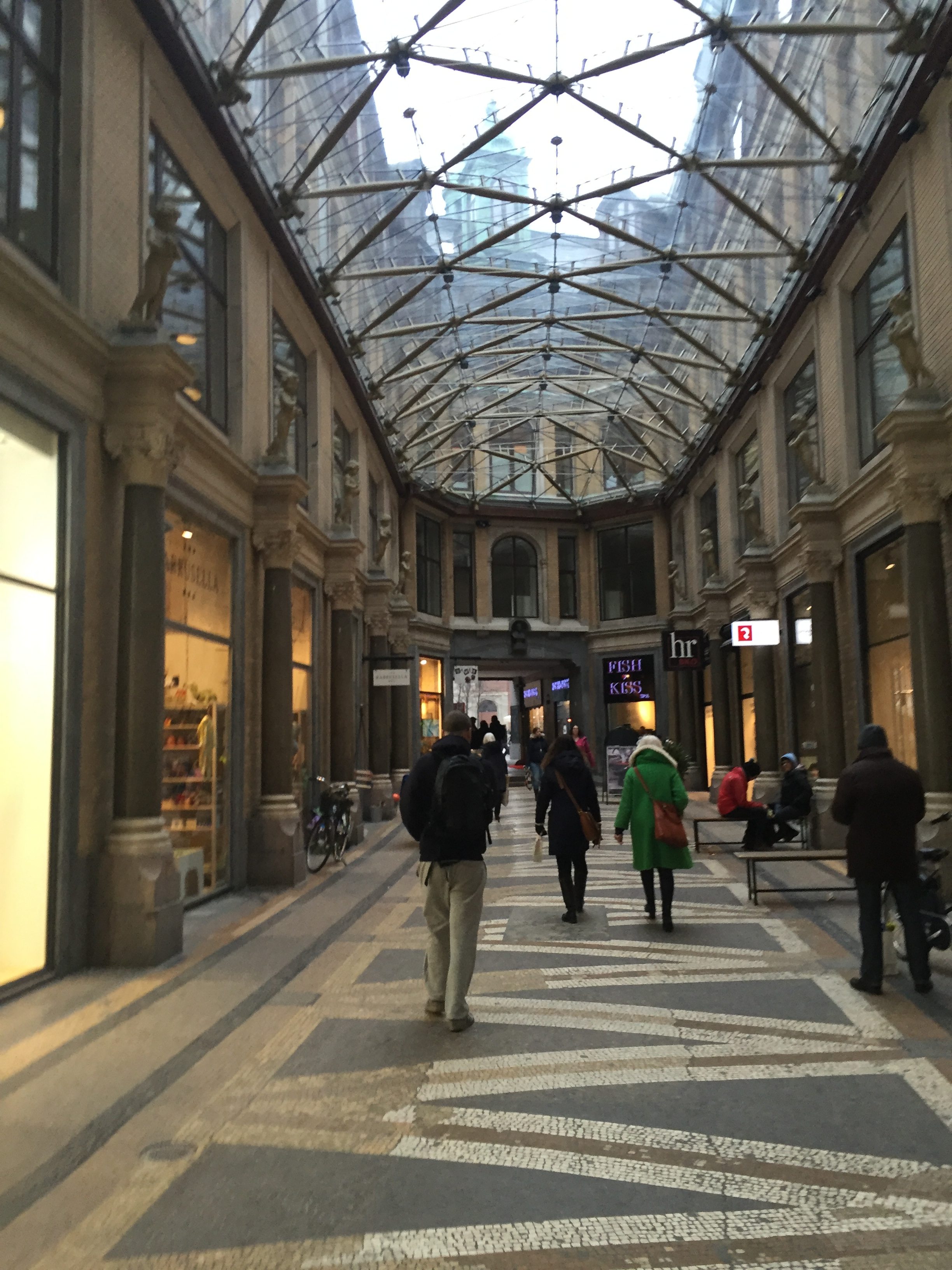

The pass-through varies from 20’ to 25’ in width, is approximately 18’ to the ceiling, and the enclosing walls are constructed of durable vandal-resistant materials, such as flat metal panels and masonry.
Light in the pass-through is a combination of ceiling-mounted downlights to create an even illumination on the ground plane and wall-mounted uplights to provide overall illumination of the space.

The design of the circulation path allows all visitors to the site to use the pass-through in a safe, convenient, enjoyable manner regardless of any physical limitation they may have.
Lease Terms
The terms of the ground lease are somewhat unusual. Sound Transit will grant a 99-year ground lease to the joint venture to use and develop the sites for mixed-use, transit-oriented development. But the form of the development will have to meet terms of the Development Agreement that Sound Transit entered into with the City of Seattle for the properties in 2013 and be substantially similar to the proposal that Gerding Edlen submitted to Sound Transit in November 2014. Given that Gerding Edlen’s proposal was extraordinarily well put together and that the community process has been highly cooperative, achieving quality products during design and land use review probably won’t be a challenge for joint venture.
Gerding Elden and its equity partner won’t have to pay Sound Transit the full rent due for the lease. Instead, the joint venture will be responsible for putting down a $444,700 security deposit up front and paying an annual rent of $222,235 until the “bulk rent payment” becomes due. Although, the annual rent paid during construction will be credited toward the bulk rent payment. The exact bulk rent payment due is dependent upon when the lease is paid in full. The longer the joint venture defers payment of the bulk rent, the higher the rent will be, which means that it could range somewhere between $18 and $20 million in net present value (the actual net present value as estimated now is $17,435,000). The deadline for payment is either upon sale of any ground leases and development to a third party or December 31, 2033, whichever comes first. The joint venture, however, would not be allowed to sell any portion of the ground leases until after the project is complete in full and the bulk rent payment itself has been made. Amortizing some of the costs for environmental remediation, the bulk rent could be reduced by $830,000 if the developer has to cleanup the site.
The lease terms also have generous language for both the developer and Sound Transit, but which is mostly stacked favor of the transit agency. Since Sound Transit is offering a 99-year ground lease, the agency would automatically assume the site and any improvements remaining at the end of the lease and could sell the properties, hold on to them, or lease them again. In the event that the lease was terminated by the leasee, Sound Transit would take back full ownership. If Sound Transit chooses to sell property either during or after the life of the lease, the then tenant–whether the current developer or future tenant of the lease(s)–would have the first right to purchase property from Sound Transit at fair market value.
Since Gerding Edlen will be developing on an active transit facility, Sound Transit will maintain a blanket right to operate the site as a transit facility. This means that the leasee may not “compromise or diminish” the operations of the transit system in any way despite sole rights to the ground lease.
Moving Ahead
Sound Transit hopes to move the project ahead next month with a Notice to Proceed. Gerding Edlen will get the green light to begin the permitting process, which will likely kick off with design review. Construction is expected to start sometime in Spring 2018 and could wrap up in Fall 2019.
Stephen is a professional urban planner in Puget Sound with a passion for sustainable, livable, and diverse cities. He is especially interested in how policies, regulations, and programs can promote positive outcomes for communities. With stints in great cities like Bellingham and Cork, Stephen currently lives in Seattle. He primarily covers land use and transportation issues and has been with The Urbanist since 2014.

